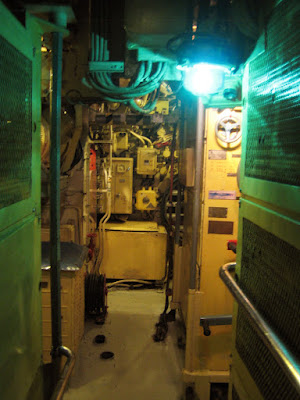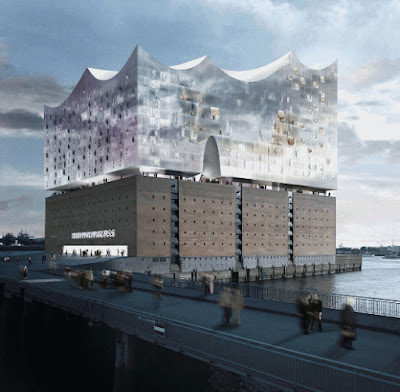Hamburg
Nikolai Kirchturm (Tower of St. Nicholas) preserved as war-torn memorial.
51-bell
carillon with tunes four
times a day played by musician in glazed room - the resonant music can be heard at
great distance.
(Photo from www.immo-news.net)
Chilehaus, designed by Fritz Höger and completed in 1924, witnessed Hamburg as a glorious sea port. The stylish emporium – Manufactum, located at the north of the building, houses large collection of German functionalist aesthetics.
An early
modernist skyscraper of 1924 with lifts and reinforced concrete framing. Paying homage to the original owner who made a
fortune whilst in Chile, delightful seafaring details and exotic references are
abundant.
Sheepish
exterior of U-434. The Russian submarine turned museum, is a camouflage to the
nerve-raking interior.
Wonder how people manage to work in this claustrophobic space amid maddening noise.
Intestinal
enclosures: there are hundreds of pipe, meters and valves cluttered everywhere
including corridors.
Authentic 19th century canal and warehouses comparable in scale only to those in Manchester of England. The Speicherstadt district (City of Warehouses) is undergoing ambitious revamp from public and private sectors.
Hamburg
Urban Development Centre: 20 year re-development plan to revive southern side of Hamburg. HafenCity is destined
to be one of the biggest urban and architectural experiments in Europe.
Much
awaited Elbe Philharmonic by Herzog & de Meuron to be completed soon
at HafenCity.
(photo from www.architecture.com)
Science
Centre designed by OMA in 2008: still torturously going through planning stage with no date
for construction yet.
(photo from www.hafencity.com)
Meet Der
Floss (The River), 1939 - the unsettling
sculpture by Aristide Maillol (1861-1944) depicting a woman stabbed at the back
and fallen. This piece is located
outside Hamburger Kunsthalle, a similar piece cast in 1948 is found at the
MoMA, New York.
Example
of German attention to details and love of the orthogonal grid: there are no
cut tiles on the floor and walls; it takes determination and stamina to arrange the
mirror and toilet accessories in module.
Consider the virtue of discipline from a different
perspective, it also calls for collective commitment to fill up this joint with
graffiti. And the room looks zippy enough.
Theatre district with outdoor stage at St Pauli
district.
The
famous red light district has been gentrified enough for curious tourists.
Lübeck
Pedestrian friendly World Heritage
Site in Germany: Lübeck manages to retain the basic medieval city fabric and
some Gothic architecture. A pair of lions
guarding the city gate refers to the founder of Lübeck - Heinrich der Löwe (Henry the Lion).
Street scenes.
St. Peter’s
Church (Petrikirche): the enlightening interior has a modern appeal and more to
offer artistically than the exterior.
As in most scarred heritage in Germany, architectural remains are meticulously preserved no matter how small.
Leipzig
City
centre with balanced variety of shops and engaging street decor.
Apart
from the anonymous shopping malls, there are historical arcades with winding
internal streets to be explored.
Truncated
street frontage of building facades leaving the war scars barely visible.
Museum
of Fine Arts sits audaciously among traditional buildings.
The lawn and resulting setback make clever
transition with the existing surrounding; however the cypress trees weaken the
intended boldness of the architecture.
Classically
proportioned Leipzig Opera House, designed and built during the communist era,
is a novelty at the busy Augustus Platz.
At one side of the square lies an ugly building (Universität Leipzig) designed by the Dutch
architect Erik van Egeraat.
Casually
fashioned with mixed bag of historicism, Gothic style and contemporariness, not
only is this a rare find in Germany, it gives modern architecture a bad name.
The incongruous architecture surrounding the square leaves a lot to be desired.
Recommended
visit: 500 year old Auerbachs Keller (Auerbach’s Cellar). The restaurant was enshrined
in the play - Faust I by Goethe.
Extended
from the restaurant, the Mephisto Bar offers excellent German cakes at
reasonable prices.
Dresden
Heroically modern slab block that seems to extend infinitely.

Cardboard alike
buildings at Neumarkt Square. Regrettably, not many buildings were left after carpet bombings in the Second World War.
buildings at Neumarkt Square. Regrettably, not many buildings were left after carpet bombings in the Second World War.

Smart
street performer spotted me photographing while posing with children. Of course, I duly paid for his service
afterwards.

Like many historical buildings in this
city, Dresden Cathedral was literally reconstructed from ground with original
rubble.
Side
chapel of the cathedral with modern alter.
Cold
November afternoon at the promenade along River Elbe. The fall in temperature and receding daylight
leave very few to cross the bridges to Dresden Neustadt.




















































